Facilities in the continuity cubicle were rudimentary, the very basic mixer being fed with sources selected remotely in the Control Room rather than by the operator. Photographed not long before the building was finally vacated, young Technical Operator Jim Bartlett presides at the desk.

The announcer was provided with facilities typical of the time. The main studio microphone was an original BBC "PGS" (Pressure Gradient Single [magnet]) with its commercial version - an STC 4038 - on a desk stand as a spare.

Dramatic developments came in 1966, with the opening of a new, ultra-modern, Broadcasting House several miles away in Llandaff. It was ultimately destined to bring all Cardiff's radio and TV facilities onto the same site, but the first phase basically supplanted Park Place and consisted of three blocks housing radio studios, offices and technical facilities respectively.
The "Tech Block" was a two-storey affair, wherein the ground floor accommodated the Selector Room, Main Distribution Frame (MDF) and maintenance workshops. Above, on one side of the first floor corridor, was the "Operations Centre" - a contemporary title for what in London (and hitherto in regional centres) had always been called the "Control Room".
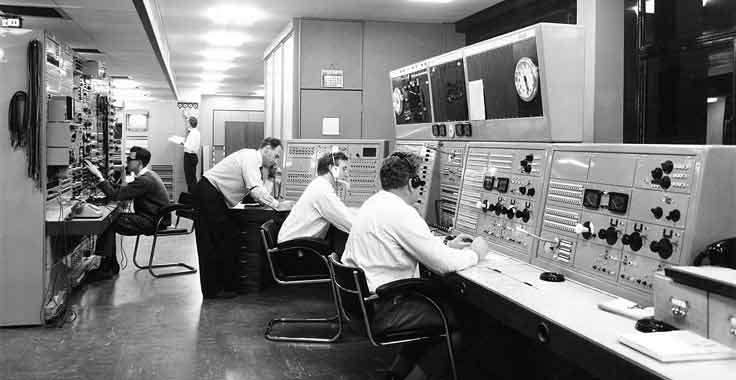
In this official BBC photograph, the brand-new Operations Centre is pictured in November 1966, four months before the building was officially opened by Princess Margaret. The figures in the foreground are (left to right): Ernie Allen (at the OB bay), Tech Ops Supervisor Joe Scott (on the telephone), Mike Meredith (operating the EMX - Engineering Manual Exchange)
Related pages
On the opposite side of the corridor were Recording Channels W7, W8 and W9 ("W" being the designated regional prefix for Wales) and the radio continuity suite. Sandwiched between W7 and W8, and usable by either, was Studio 7, which was frequently utilised for talks and interviews.
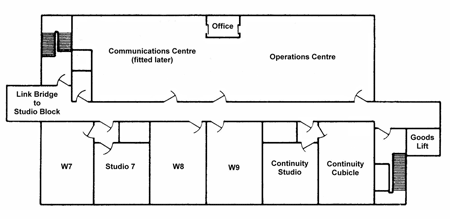
right: Plan of the first floor of the Llandaff Technical Block as originally installed.
The facilities of the continuity suite were fairly standard for a BBC regional centre of those days. Continuing seamlessly from Park Place, its primary function was periodically to opt-out of the Home Service (almost immediately re-branded as Radio 4) and insert local programmes and announcements.. The mixer desk was interesting however, since, although it bore more than a passing resemblance to a Type B installation, it was fitted with first-generation transistor amplifiers - in line with the innovative Type C equipment installed throughout the whole building.
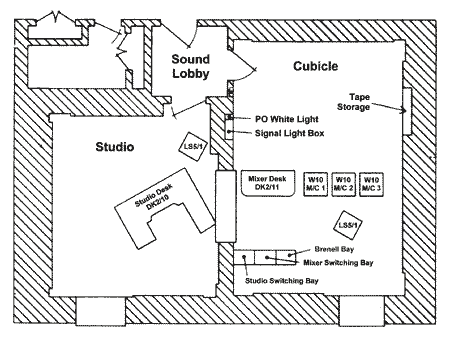
left: Plan showing layout of continuity suite.
The mixer was designated as a DK2/11, the Technical Instruction describing it as "part of the prototype EP10/13 equipment for integrated Regional Studio Centres." One trivial memory that springs to mind is that the spare main amp sat poised in its bay slot behind the operator's position without being pushed fully home. Leaning back in the chair and inserting it completely would double terminate the circuitry and reduce programme level by about 3dB!
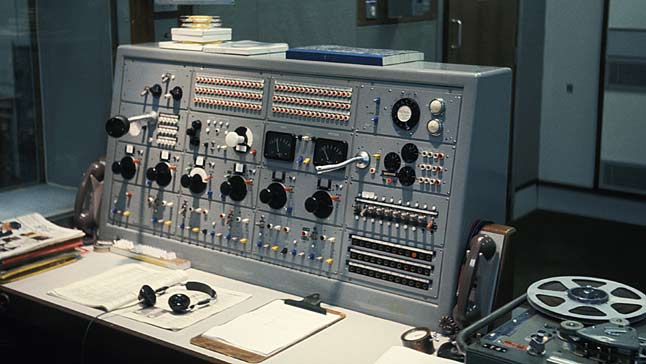
A line feed of "Basic" Radio 4 was permanently wired to the extreme left hand fader (Channel X), and there were five other channels with full selection and control facilities. The first of these (Channel Y) invariably carried a re-broadcast receiver ("RBR") feed of Radio 4 from Brookman's Park in case the incoming circuit should fail. This general view of the Technical Operator's position shows the suite live for a lunchtime opt-out circa 1972. Basic Radio 4 is faded out, and a local studio faded up on Channel 1. The strip of wood towards the left of the desk was slotted, and stored plastic labels engraved with the names of the most commonly used sources - there being no sophisticated electronic system to indicate at a glance what had been selected to any channel. The TR90 tape machine, being the left hand one of three, would have been operationally designated as W10 M/c 1 (see below).
Given the smaller number of available sources compared with a London suite, selection was simpler, and it was necessary only to lower a channel's "Kellogg key" (to prime its associated uniselector) and press one of the 102 source buttons on the top panel. Within a couple of seconds, a red light above the key would illuminate to show that selection was complete. Returning the key to its central position deselected the source, so long as the channel fader was completely shut (a sensible safety measure!).
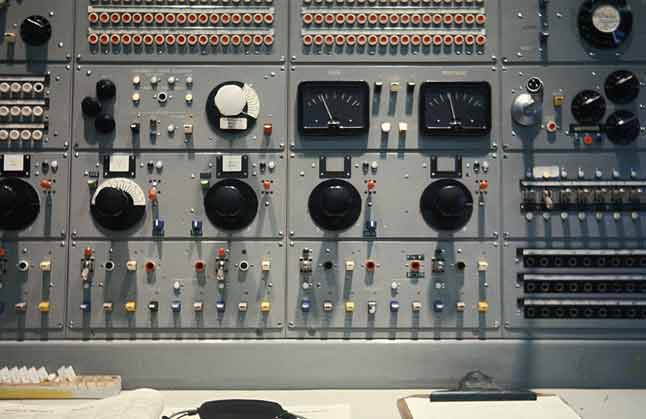
This picture shows, in addition to the channel in current use, the semi-permanent RBR Channel Y (left) and Fader 2 selected to the news studio in readiness for the subsequent bulletin. The bottom row of keys controlled various telephone and control-line functions for the operator and announcer. The lowered Kellogg key near the right hand side was one of the pair used to start and stop the Brenell network logging machines - the transferable home-made paper label perched on the white indicator light reading "THIS ONE"! The Brenells were housed in the bay behind the operator and ran at 15/16 ips, remote control being effected by leaving them mechanically "in gear" and simply switching the capstan motors. Seven-inch reels were re-cycled over a period of weeks, and the machines were operated sequentially to provide more-or-less unbroken recording. At any time, the operator's cue to start the "other" one was when the unmistakable sound of flapping tape confirmed that the previous spool had run out! Off-air monitoring (the normal loudspeaker feed) was available from both Wenvoe (VHF) and Washford (Medium Wave). For the sake of quality, the former was normally selected, although there was a sequential option that switched automatically between the receivers at half minute intervals. In those halcyon days before transmission processing, it was virtually impossible to discern any difference between local output and the returning FM signal.
The broadcast tape machines were officially designated W10 M/c 1, 2 and 3 respectively. They were used almost exclusively by the continuity suite, but nevertheless appeared on the source multiple and thus could be accessed for recording or replay by other control areas. This however, along with sundry other facilities in the state-of-the-art building, was a rare occurrence. Several types of tape machine could be found here at different times. During the early days there was usually at least one TR90, and Philips EL 3566 machines were also common. Progressively, as stereo machines began to become the norm, even in mono areas, both types were supplanted by trolley-mounted B62s and, latterly, an occasional Leevers-Rich Mk. 6.
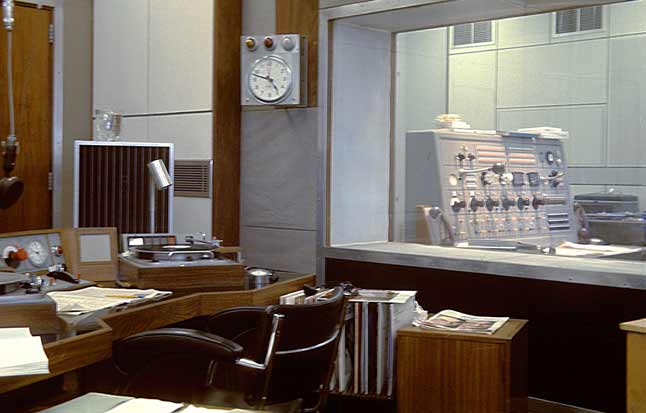
The announcer's studio was photographed on a different occasion. A glance around confirms that basic Radio 4 is faded up and the red light is off, making it almost certain that the suite is out of circuit between programmes.
As originally installed, the main announcer microphone was a 4038, hung from the ubiquitous elastic suspensions, with a PGS mounted to one side as a spare. When, later, a D202 was substituted, there was a deal of head-scratching when it sounded very bass light. Eventually, someone remembered that permanent speech installations designed for ribbon microphones were often fitted with hard-wired
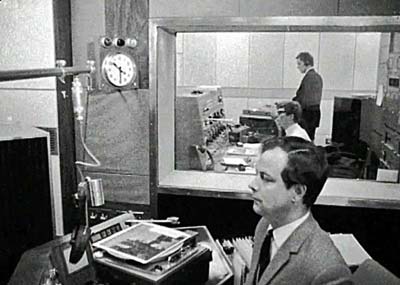
BBC Wales Film Unit shot a good deal of 16mm archive material during the building of BH Llandaff. From that footage we see, right, announcer Iwan Thomas (mentioned later) practising an opt-out during familiarization tests in 1966. The technical operators are unknown, but the tape machine appears to be one of the Studer C37s eventually destined for W1 (the recording channel dedicated to the orchestral Concert Hall).
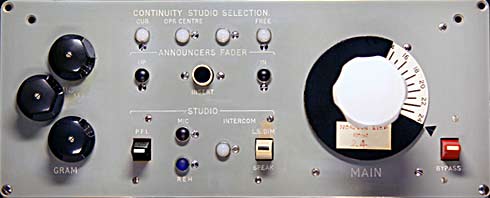
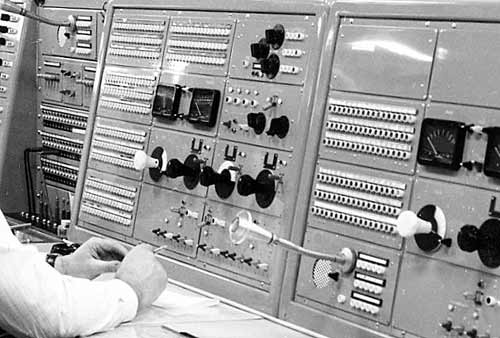
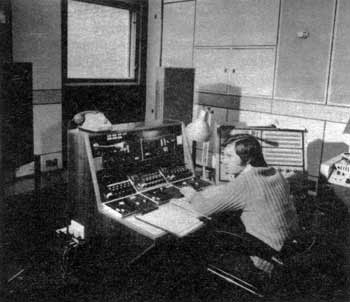
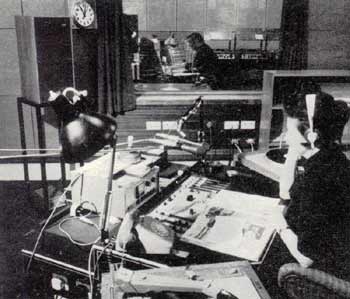
The studio (left) was equipped with a Radio 1 Club type self-op desk. Monitoring in both the studio and cubicle was by means of Spendor BC1 loudspeakers, driven by HH AM8/12 amplifiers.
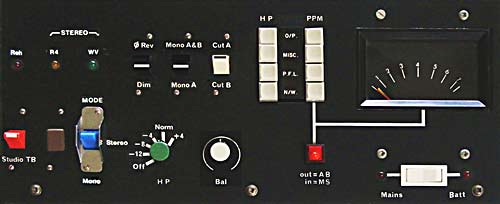
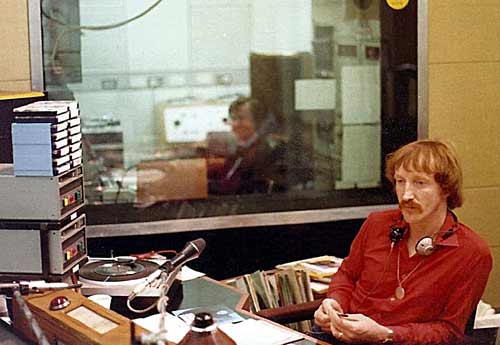
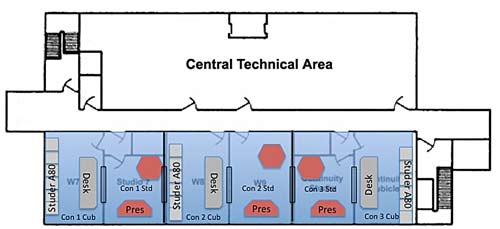
When the two language services first separated, English programmes were temporarily consigned to medium wave only. The original mono Con therefore remained suitable for use, but was heavily modified to permit D.J. self-operation. Radio Wales presenter Mike Flynn is seen in the studio, with T.O. Jim Bartlett (pictured earlier in Park Place) behind the glass. A new microphone and turntables are evident, along with cartridge machines and stacks of jingles.
Progress marched on, and during the 1980s the entire length of the Tech Block became home to three identical "Maxi Con" installations, a project overseen by Assistant Audio Manager, Dave McCarthy. Steve Jones (who worked in Cardiff before lecturing at Wood Norton) provided this overlay diagram to show how the conversions were implemented. The area which had housed the temporary facility kept its existing title of Con 1, the rooms of the original suite were designated Con 3, and Recording Channels W8 and W9 were re-built as Con 2. Windows were cut through the remaining solid dividing walls, in case more extensive visual communication was ever required. By this time, the former Operations Centre had become an integrated "CTA" for both sound and television.
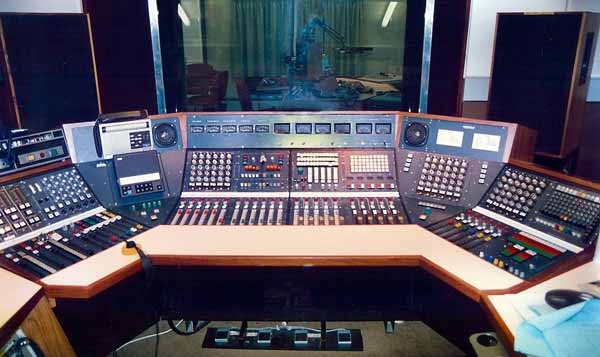
The Maxi Con desk was conceived by Dave Smart of BBC Designs Department, and was a first in using VCAs to give remote control of the facilities. The new Cons were much more flexible than any other studios in Cardiff at the time, being able to handle up to 11 outside sources simultaneously. This proved invaluable when they were used by Sports Department whilst the normal production
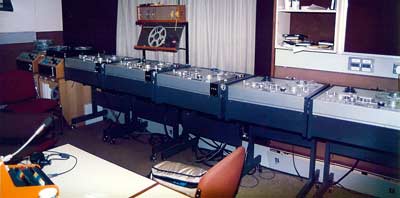
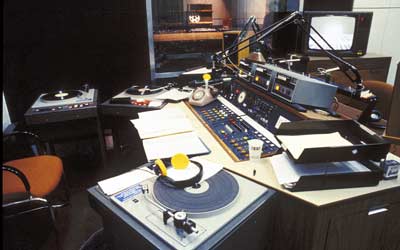
Two pictures taken by Steve Jones, c.1984, (above and right) show the desk in Maxi Con 2, and its bank of tape and gram machines. A row of five Studer A80s makes an impressive sight!
The studio of Maxi Con 1 (right) was photographed by the writer at around the same time, and shows the excellent presenter facilities, including three E.M.T. turntables.
To keep the networks running during the various developments of the Llandaff continuities, operations de-camped to a pair of Portakabins (resembling caravans without wheels) parked outside - a facility cheerfully known as "Cara-Con". During one of these temporary periods of exile, Welsh language presenter Richard Rees is seen (below) in the rudimentary studio, whilst his producer, Eurof Williams, supervises from the control area.
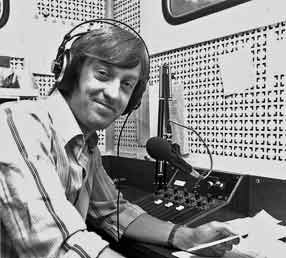
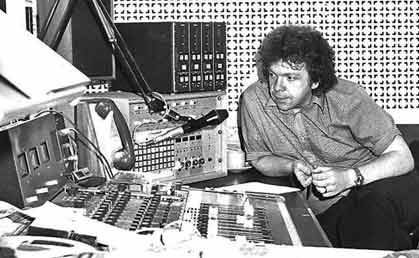
Despite being arguably the final development of "traditional" continuities, the Maxi Cons had a relatively short lifespan, since both Radio Wales and Radio Cymru were to develop house styles that suited putting production studios direct to air. Residual continuity functions, e.g. handling certain recorded programmes and complete OBs, were thereafter dealt with by a pair of Presenter Operated Transmission Studios (POTS) built on the ground floor of the adjacent studio block - another development instigated by Dave McCarthy, by this time wearing a new hat as Planning Manager, Radio. Announcers in POTS performed all operational tasks themselves, with no on-the-spot technical assistance, and, as this picture of POTS 1, below, shows, the scene is more reminiscent of a local radio station, with facilities for originating simple self-op programmes with guests. It was all a far cry from the labour-intensive, jack-plugged era of Park Place.
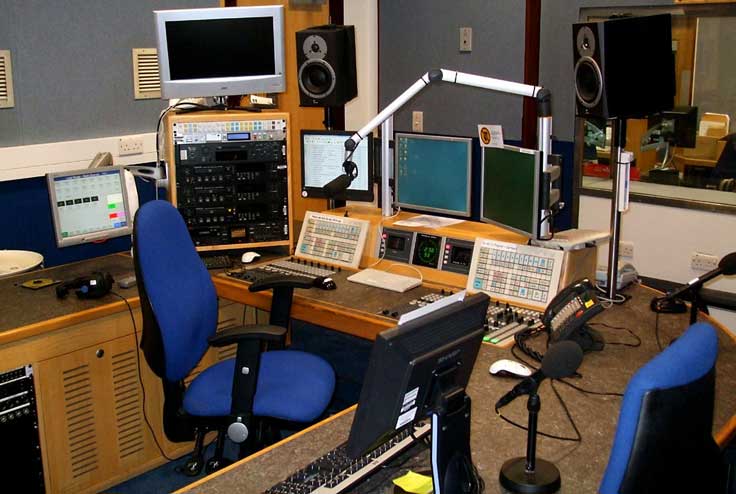
In 2020, to the delight of some and dismay of many others, the curtain finally fell on BH Llandaff with the opening of yet another "new" Broadcasting House in Cardiff's Central Square, the £120m state-of-the-art edifice now greeting travellers as they exit the city's main railway station.

Integrating radio and TV, and the first BBC facility in the UK to utilize IP technology for both production and broadcast operations, Central Square stands just a crow-flying kilometre from Park Place, yet a million miles away in both technology and aspirations. All manner of marvels are now possible, and with radio studios fed straight to air as the norm, remaining continuity procedures are dealt-with in areas known as "Audio Workshops" (Workshop 1A pictured). In an ironic reversal of the earlier POTS operations, however, Radio Wales has chosen to dispense with continuity announcers and rely upon computers to deliver programmes in a timely fashion.

Changes since the Reithian days of 5WA have been nothing less than phenomenal, and as a postscript, one wonders whether the present occupants of 39 Park Place and thereabouts realise the significance of their location - or if the residents of a development grandly titled "Parc Llandaf" appreciate that half of that century of broadcasting history lies in rubble beneath their executive homes. O tempora, o mores.
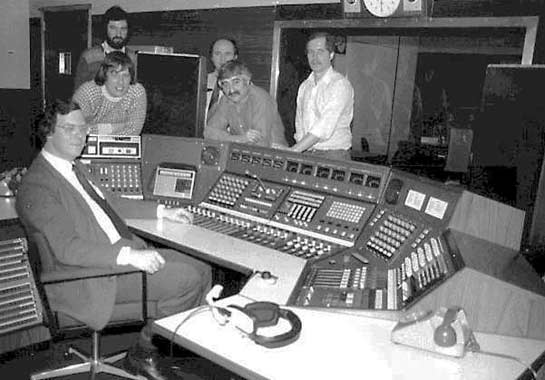
Dave McCarthy sent this photo of the mixer (built by BBC Equipment Department) in Maxi Con 1, just before it entered service, c.1981. Dave is in the hot seat, and the others are various members of the installation team, including John Meredith, Dave Lawson and Peter Eaves.
John Meredith writes:
"The two other guys are Johnny Fabricci (wireman) and to the right I think is Johnny Stewart. The picture leaves out Graham Innes who did a lot of work on the cubicle logic for red lights, intercoms etc. I worked on the units when they were first constructed and assembled in Windmill Road in Acton where the BBC had a factory that pre-assembled many installations. Myself and Etienne Evans, who also worked on Cons 2 and 3, dismantled Con 1 in a day. It had taken 6 months to construct and test. Just before the first (40 minute) transmission the desk failed because of faulty crimps in a module due to a worn crimp tool. It was all hands on deck while we tore the desk to bits to get it working. In the true spirit of broadcasting we made it on air."
Jim Bartlett comments:
"I spent many an hour there monitoring Radio Cymru programmes. The box in the corner of the desk, by Dave's left hand, is an intercom. There was a similar one by the door into the Continuity, and the highlight of every shift was when that burst into life with a cry of 'Trolley!' when the tea-lady arrived!"
This from Chris Harnett who worked at Cardiff 1969-1977:
Jim Bartlett and Geoff Atkins were contempories of mine and we all had a whale of a time. I have many, many anecdotes of sleepy operators using egg timers to make sure they woke up before programme junctions. News PAs walking through red lights to give the conty announcer a cup of tea with the greeting "here is your tea Mr. Iwan" passing the cup under the live mic only to have the spoon leap onto the heavy magnet of the 4038. This might not have been too much of a disaster if 'Mr. Iwan' (also known as Tattoo Thomas) had left it there, but oh no!, he tries to remove it and the only control I had in a type B/C continuity was to pull the main studio line amp, the studio mic amplifiers being in the studio and beyond my control. Geoff is right, leaning back on the rack had an uncanny knack of dropping the output by 3db, a trap we all fell in!
We had Philips tape machines - great to edit on but the woggle arm tensioners were prone to all sorts of problems. I remember starting a programme only to see the take up reel stop and the tape start to wiggle it's way into the guts of the machine. We are still on air though, and for a fleeting moment I wondered how much tape it could hold before it choked itself! Needless to say I jammed the woggle arm with a chinagraph, and fed the tape onto the floor, just part of the service!
I actually bought a TR90, the tape ripper, we were all wary of the rewind on this beast because if the end of tape arm hit the endstop due to a sticky edit, the brakes came on with a force necessary to stop a jumbo jet, and a spectacular confetti effect fell around you as all the oxide left the tape as it became a wire recorder!!
Anyone remember the BTR2 GT? A stereo conversion, it's phase integrity was terrible and we had 2 in W9, I was detailed to wreck them by testing them with our varispeed capstan amplifier, I cannot remember the name of the device. An hour's 'test' had 2 motor failures and a week later we had 2 Studer B62s in place, bliss.
My very worst was to have supper on a Sunday night at the Club, no canteen, two pints and a warm bay behind me and I drifted off whilst an exceedingly boring man droned on in Welsh. The Announcer had slipped off too, and so had the EMX Operator, all of us in the land of nod! Of course being an hour programme a change-over came, and went, it was only the 1 min alarm at Wenvoe that woke us all up, they rang our Operations Centre. I started the next machine at least 1 min 20 after the changeover, and we all pondered what to do about the logs and the overun. Luckily the programme was underunning by a minute of so, so an early out was decided upon, it was a formulaic ending that could loose 30 sec. without ruining the content.
What about the log! We decided that we should write 'dramatic pause due to sticky edit causing tape tension arm to drop out on start'. Not a soul complained, so as some wag later commented after we let on some weeks later, obviously BOTH our listeners had also been driven to sleep!
About a year later again, on a Sunday night, Ted Clark and I were on duty in the Ops Centre when the 'phone from reception went. I had just transmitted another boring monologue in Welsh, this time perfectly, and our irate listener wished to remonstrate with someone about its contents. The fireman/commissionaire was English speaking so passed the guy on to us, now Ted was broad Scots and had to gently ask this listener to talk in English. Red rag to bull time, Listener to Ted 'do you mean to tell me that there is only one bloody Scotsman running the whole of BBC Wales tonight?' Ted's reply - 'no, there's a bloody Englishman helping me'. Well, collapse of stout party, we never heard another word and assumed we were now down to one listener!
BBC radio had quite an influence on me, my youngest daughter is named after one of the female announcers, Rhiannon, and my audio career reached it's peak with awards for the first all digital Glyndebourne for TV. Strange world, I finish my broadcast career in cameras, I started at Ally Pally on camera ops. and maint. Allowance scale C, establishment code 11501, staff no. 137925T, signing off. Almost Satis. ( I never dared write that in the log!)
Geoff Atkins returns to expand on some of Chris Harnett's stories:
Chris mentions an announcer, Iwan Thomas (pictured above). Iwan was a Major in the Territorial Army, and his nickname "Tattoo Thomas" was inspired by the fact that he regularly commentated at the Searchlight event held biennially in Cardiff Castle. His mellifluous tones used to echo impressively across the battlements whilst bands played and bombs exploded! But the name was also a kind of bi-lingual pun, alluding to the affectionate Welsh ornithological term "Titw Tomos" (Tom Tit)!!
Scotsman Ted Clark was a Glaswegian and, amongst other things, was fond of camping. In the early days of the building, before TV moved up from Broadway studios, the part of the Ops Centre destined eventually to accommodate vision equipment was still a bare open space. I arrived for duty one morning to discover that Ted had erected his large new tent there, as a dry run before taking it into the Great Outdoors. This was, needless to say, at a weekend, so there was little danger that "important" people would appear unannounced and stumble across it!
The varispeed capstan amplifier lived in Recording Channel W8, and the method used seems positively agricultural now! On a small trolley was rack-mounted a valve oscillator with a limited frequency range of (if I remember correctly) 40 to 60 Hz, adjustable by means of a large black knob. The zero-level output of this device could be jacked into an enormous valve amplifier housed in a glass-fronted bay adjacent to the Studio 7 window. In turn, the capstan motors of the BTR/2s could be switched to accept an external supply, which in our case was the output of the aforementioned luminescent beast. Thus, adjustment of the oscillator frequency either side of the 50Hz norm altered the tape speed ... and all done thermionically! The main purpose of the facility was to pitch-correct interviews if the batteries of Uher field recorders had begun to fail. The massive power amplifier at the heart of the system bore the name "Bryan Savage", and we always delighted in telling impressionable new reporters that we were going into W8 to "savage" their tapes!

